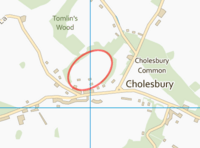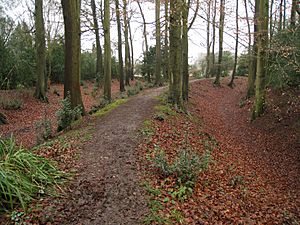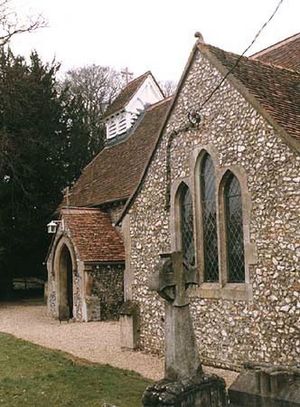Cholesbury Camp facts for kids
Quick facts for kids Cholesbury Camp |
|
|---|---|

Interior of Cholesbury Camp
|
|
| General information | |
| Architectural style | Iron Age hill fort |
| Town or city | Cholesbury |
| Country | England |
| Coordinates | 51°45′22″N 0°39′14″W / 51.756062°N 0.653957°W |
| Construction started | 2nd century BC? |
| Technical details | |
| Size | 15 acres (6.1 ha) |
Cholesbury Camp is a really old and well-kept hill fort from the Iron Age in Cholesbury, England. It's shaped like a big oval and covers about 15 acres, which is like 11 football fields! It measures roughly 310 meters (about 1000 feet) long and 230 meters (about 750 feet) wide. Inside, the ground is mostly flat and has been used for farming for hundreds of years. Today, this hill fort is a scheduled ancient monument, meaning it's a special historic site protected by law.
This fort is a "multivallate" type, which means it has two or more sets of earth walls and ditches. Most forts like this were built during the British Iron Age, between 600 BC and 1 AD. Experts think Cholesbury Camp was built between 200 BC and 100 BC. For a long time, people mistakenly thought the Danes built it, calling it "The Danish Camp." Some even think it might have been built on top of an even older defensive structure from the Bronze Age.
The fort is located in the Chiltern Hills, high up at over 190 meters (about 620 feet). It was hard to find water in this area, which was important for people and their animals. However, there are two natural water sources nearby: Holy Pond and Bury Ponds. Having a steady water supply was very important for choosing where to build the fort and for the early community in Cholesbury.
Contents
Exploring the Fort's Structure
The oval-shaped earth walls of the fort are now mostly covered by tall beech trees. These trees were planted a long time ago, in the early 1800s. Inside the walls, there's a flat area of about 10 acres, which is open and used for grazing animals.
There are four ways to enter the central area, but only one is thought to be from the original Iron Age fort. Most of the earth walls are still in good condition. However, a section about 230 meters (750 feet) long on the southern side is missing. This part of the walls was likely removed to make space for buildings and farms between the 1500s and early 1800s. Some people also think the walls here were always smaller, making it easier to build homes.
On the southeast and southwest sides, the fort has two sets of banks (inner and outer) with a large ditch between them. On the northeast and northwest sides, there's a single ditch with a bank on each side.
The inner bank is about 8 meters (26 feet) wide. It stands between 0.8 meters (2.6 feet) and 2 meters (6.5 feet) tall. The top of this bank was flat and doesn't seem to have had wood or stone lining. The inner ditch next to it is 6 to 12 meters (20 to 39 feet) wide and 2.5 to 3 meters (8 to 10 feet) deep. It's shaped like a steep 'V'. The outer bank is not as clear but can still be seen on the northern side.
A Look at the Fort's Past
When Was the Fort Used?
In 1932, an archaeologist named Day Kimball dug up parts of Cholesbury Camp. He found that during the Iron Age, the fort was probably not lived in all the time. It was likely used as a safe place or a defense during times of trouble.
They found old fireplaces and a clay oven. Three of the fireplaces seemed to have been used to melt iron, as they found pieces of iron waste called slag. They also found a few pieces of pottery from the Middle Iron Age. However, there were many more pieces of pottery from the Late Iron Age (around 200 BC to 50 AD). Some rare pieces of grinding stones, called quern-stones, were found too. These came all the way from Germany, suggesting it might have been an important camp.
The main time people used the fort seems to have been around the middle of the 1st century BC. Kimball also thought there might have been an even older earth structure before the main fort. He noticed that there was almost no pottery from the Romano-British period. This suggests the fort was mostly empty from the time the Romans arrived in Britain around 54 AD until the early medieval period.
In 1953, a small gold coin was found by accident inside the Camp. This coin was made in Europe between the mid-2nd and mid-1st century BC. Finding this coin helped confirm the time period Kimball had suggested for when the fort was used. Such coins could have been from trade, a gift, or even an offering to ancient gods.
After the Romans Left
After the Romans left, people started clearing land for summer pastures. A small village slowly grew near the fort, connected to a place called Drayton Beauchamp. More people began living in and around the fort during the later Anglo-Saxon period. This led to the growth of the village we know today as Cholesbury. The first time the village name was written down was in the late 1200s, as Chelwoldesbyr. This name comes from an Anglo-Saxon phrase meaning "the fortified place of Ceolweald's people."
The Medieval Period
Kimball found a few pieces of medieval pottery in 1932. He thought these were not from people living in the fort again, but from farmers spreading manure on the fields outside the Camp. However, a special survey in 2000, using geophysical tools, suggested that the inside of the fort might have been used again in the medieval period. The survey found possible signs of an early manor house, which would have been connected to the church that dates back to the 1100s. Later, the Cholesbury Manor House was built in the 1500s, right on the southern part of the fort's earth walls.
The Church of St Lawrence
Today, the Church of St Lawrence stands inside the old defenses of the Iron Age fort. It's one of only two churches with this name in Buckinghamshire built inside a hill fort. Its location suggests that the fort was still important, maybe for religious or political reasons, long after its original use was forgotten. The oldest parts of the church were built in the Early English Style, meaning the original stone church dates back to the 1100s or 1200s. It might have replaced an even older wooden church from the Anglo-Saxon period. After falling into disrepair, the church was partly rebuilt and fixed up in the 1870s.
Images for kids





